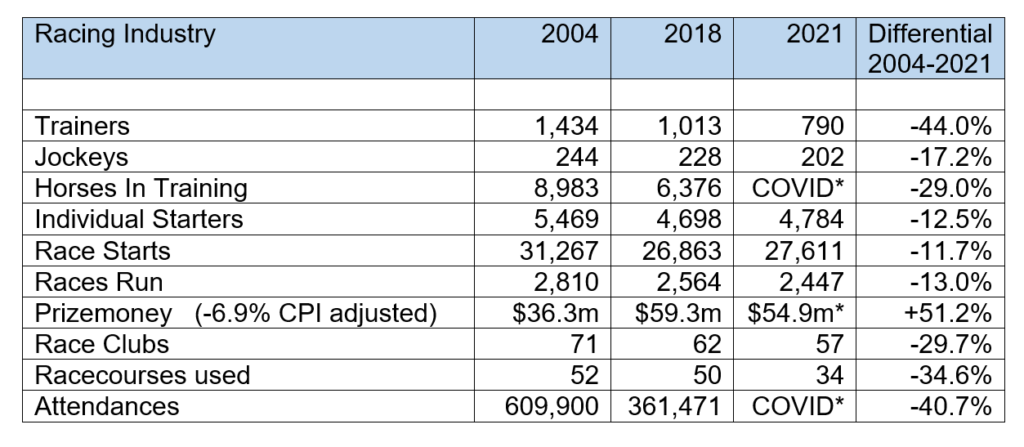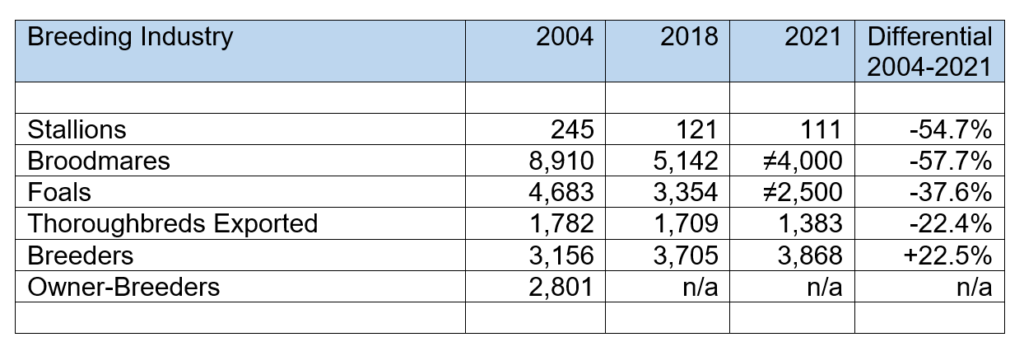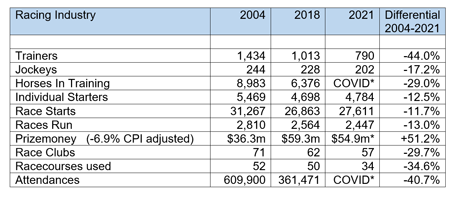by Brian de Lore
Published 7th January 2022
The thoroughbred racing industry in New Zealand continues to plot its own path to penury with hapless decision-making, a lack of empathy for the stakeholders, and an apparent inability to recognise ‘the fix’ or the changes required to make racing sustainable.
The dawning of 2022 hasn’t thrown up any new hope, in my view, for a failing industry run by lightweights incapable of righting the course of the ship. Essentially, it comes back to leadership and the quality of the people in charge. Too many involved today have entered racing from the outside because of directors’ fees or the offer of an executive position with a hefty salary.
It’s no longer about people with a racing passion. Whatever way you assess it, the system and structure is broken and badly needs a trip to the ‘The Repair Shop.’ Only a major overhaul will suffice; the Racing Act of 2020 is not the panacea Winston Peters said it would be – it opened the door for more government control and a faster decline.
The narrative and tables that follow in this blog show conclusively that racing’s future is financially unsustainable with the current structure using the same people. The factual figures drawn from industry publications are uncontestable. They come from Size and Scope Reports, Annual Reports, Stallion Registers, etc.

Let’s compare two figures and try and make sense of it. In 2004 we had 1,434 registered trainers, and the Racing Integrity Unit cost $1,188,214 for the season. In 2021 the number of registered trainers had reduced to 790, a decline of 44 percent. But the RIU, which is now the RIB, will cost $14.2 million this season – an increase of almost 1200 percent from 2004.
Racing in the 2004 era didn’t particularly have an integrity problem out of the ordinary, and the scrutiny of trainers is only a tiny area of its jurisdiction, but how do you equate an almost halving of the number of trainers over 17 years during which time there’s a 12-times increase in the cost of integrity?
Over-indulgence in the use of industry money for administrative expansion over and above putting it into stakes isn’t a new trend for racing. NZRB, when run by Glenda Hughes and John Allen, blew $200 million of potential stakes money when they signed up the TAB for the Fixed Odds Betting Platform instead of outsourcing the service to TABcorp or Sportsbet. They walked free, and we inherited the legacy – that’s justice for you?

When they departed the carnage, we all thought the ‘gravy-train’ had finally derailed itself. But no, NZTR had already climbed aboard. In the 2004 to the present era of comparison in the accompanying tables, it’s safe to say racing has declined by 25 to 30 percent overall. But against that trend, the cost of running NZTR far exceeded the CPI index by rising to $10,890,239 or just on $210,000/week for last season, an increase of 271 percent on 2004. Salaries for the same period rose 631 percent to $4,124,624.
If a counter-argument to justify current costs could be mounted through a revival of industry fortunes, my accusations would be less impactful. But exponentially rising costs for an owner to go racing against the potential return, tells us the angle on the descent graph has steepened in the last year.
Worst still, NZTR costs will rise again this season. It has created a new position and employed a Chief Operating Officer, one rung below CEO Bernard Saundry. The board also plans to open an office in Cambridge (and at what cost?) because Waikato is the hub of the industry, and the location better suits the Auckland-dominated board. Given the state of racing, the move has no justification.

The board apparently had initially planned to shift the entire NZTR staff to Cambridge, but when several said they wouldn’t go, having two offices became the plan which has remained reasonably hush-hush. Chairman Cameron George, who has resided in Australia for the past year, said when elected in November 2020, he would run NZTR transparently, but quite the reverse has resulted.
Missing in Australia for an entire year, George now isn’t alone. CEO and fellow countryman Bernard Saundry flew to Melbourne the week before Christmas, so will either ever get back? Unless Minister of Racing Grant Robertson has issued a pre-departure return pass for Saundry, the COVID-19 website states that a ‘critical purpose to travel’ to New Zealand is required to enter New Zealand – and that’s for New Zealanders.
Saundry’s replacement will soon be announced, as will replacements (2) for the NZTR board. Short of Peter V’landys, who could turn this shambles around and make it work?
Today is January 7th, but if you’re a trainer looking to plan a campaign for your horses, after March 21st, nothing appears on the website for race programming or stakes money. My information is that NZTR’s promise last July to announce winter prizemoney from April onwards by Christmas did not happen because ‘they forgot.’
In a lame-duck press release sent to stakeholders on December 23rd, NZTR blamed the Delta variant and its effect on gaming income as the reason the stakes announcement didn’t happen and isn’t happening now until February. Why did they say that when gaming income has never factored in providing stakes for racing – someone made it up, with both George and Saundry’s signature on it dated the 23rd and neither in the country.
Like other press releases, they told readers how wonderful they’re doing with the usual spin that makes your eyes glaze over.
Last October, they sent stakeholders an NZTR Directions Update after receiving 40 submissions. Given their past record and the fact that the board is very upper North Island top-heavy, how can they be trusted on the following themes considered for changing at their February meeting.:
• Venue classification
• Investment of increased prize money – new initiatives Vs lower grade racing.
• Venue sale/use of assets for national, regional, or local purposes.
• Strengthening of certain areas in the North and South, possibly at the expense of other areas.
• Rotation vs Permanent placement of proposed initiative events.
Sorry, but where’s the NZTR record of good money management and cost control? None exists, so why would a Dargaville or a Timaru Club gladly hand over its 100-year built-up assets to an organisation which is just as likely to build itself a flash office block in Cambridge or have another round of salary increases?
NZTR has failed to draw up a commercial agreement with the other two codes and take it to TAB NZ, despite that direction having appeared in the Racing Act of 2020. That failure has cost the codes dearly as TAB NZ has $13 million on deposit that should have come down to the codes for prizemoney. Previously I identified that problem in “What TAB NZ doesn’t want its stakeholders to know,” published on November 2nd.
The latest NZTR’s Annual Report on page 13 says the following under, ‘nztr statutory role’:
(e) to distribute revenue received by the code to racing clubs registered with the code.
Then go to page 35 and see they have a total of $8.5 million on term deposit that, under their statutory obligations, according to the Act, should have gone to the clubs for distribution as prizemoney. NZTR had only $1 million on term deposit in the previous year. This is a cut and dry case of wrongful withholding of monies belonging to the pool of stakes money. It’s called defrauding the clubs and consequently the owners.
Racing doesn’t need this sleight-of-hand carry-on; it needs to survive and deliver everything it can to the grassroots. The clubs are the heart and soul of racing; it’s where the thousands of volunteers turn up as committees and workers because they have a passion for racing.
New Zealand can’t achieve Flemington and Randwick quality racing by selling up its grassroots to fund it – Australian racing has five levels of racing, and each exists to support the next level up. Our problem is we have five levels of administration, and none appear to be better than mediocre.
Everyone who has thought about it knows deep down racing has to change dramatically to survive – instead, we are in denial heading down a sinkhole. How do you keep justifying increased running costs for an industry in a severe state of numerical decline? The tables herewith tell the story.
Racing through NZTR doesn’t convey the truth; it covers up to make things look okay. And it lacks the fundamental integrity and passion of the people who ran it successfully in the previous millennium.

Footnote: The number of breeders in 2004 of 3,156 owned an average of 0.88/broodmare. By 2021, although increased in number to 3,868, the average ownership diminished to 0.34/broodmare.


That is very sobering reading Brian
How long can it carry on or have we passed the point of no return,
Kurow put through $115k on course and a total of near $1150000
It cost Nztr very little if nothing apart from stakes , it would be interesting to see what Ellerslie did in the new year and compare the associated costs
Cheers Simon
How can the people who are presently in charge of running Racing in this country dare to venture outside . It is disgraceful to see what they are paid and what the administration costs. There is absolutely NO JUSTIFICATION for it.
I first owned horses in this country in 1991. I first started breeding here in 1993. I still have horses in training here and I still breed horses here , but I cannot continue unless there is a major change. We were given a blueprint by John Messara of what to do. He did all that work for us at his own expense. Did we attempt to follow it…. No. We must be the laughing stock of the World to be in the mess we are, with the salaries the board are paying themselves and the HUGE number of people now employed. Let’s face it, game over.
Well written Sir,the facts and figures can’t be disputed and you will note that those with their heads in the trough the deepest don’t try.
I agree with Henrietta the industry is a disgrace and for me it’s a slowly sinking ship,no accountability,grossly over paid and over staffed.
I feel sorry for those business organisations who have a serious investment in property stallions mares etc ,with such a shambolic way forward.
How do you conduct an orchestra when you don’t even live here? But wait in time they will pass the baton and take the money with no recourse or accountability.
Game over for us as we slowly scale down and move stock off shore.
The administration of the thoroughbred racing industry needs significant restructuring . The racing administrators who make no mistake are in control of the thoroughbred racing industry . The layers of administration need to be stripped away and this needs to start at the top . I suggest starting with the ineffective Members Council who the Board of NZTR are supposed to be accountable too. They are simply not up to the job and it shows .A selection committee of racing people with the relevant commercial experience should select the NZTR Board . My suggestion is the NZTR Board should consist of four Directors nominated by the clubs and one each representing the breeders, trainers/jockeys and the owners. Each of these Directors should be held to account for their performance by the bodies who they represent.
You may need to take a trip to south Island and have a look at how Oamakau Trotting club showed the money boys how to get following
1/ A full crowd to the races
2/ A star trotter for a star performance, they paraded him down the front straight to an applause.
3/ Entertainment for the whole day.
4/ the president interacted with the crowd, children included.
5/ the committee showed the crowd what hard work supplies entertainment
6/ volunteers from the country supplied stations required to run show.
7/ totalisation that coped with crowd.
8/ I would be interested to see balance sheet compared to and auckland or other big racing club.ie bottom line(profit)
Well done Oamakau committee.
9/ summary – they got off backsides and hardwork provides enterment when its about survival!!
Brian for anyone involved in racing your posts are more scarier to read than a Stephen King novel. If you know anyone who is writing a book on horse racing ‘jokes’ make sure you get them to include NZTR senior management.
As always well said Brian. Any other industry leaders would be shifted sideways and people with skills and the racing industry at groundhog level appointed to try and right our sinking industry. Cambridge is heralded as the home of or hub of racing but whilst this may be true it is the punters who provide the dollars to sustain racing! Continued over spending and an industry run by Aussie administrators to with jobs for the boys is a proven failure. Club assets can only be disposed of once and there is no chance of going back. The heart of racing has been damaged beyond repair. Plus the land grab is not only morally wrong but would love to see this argued in a court . It’s the same as what Iwi were subjected to hundreds of years ago. The clubs that have had millions of industry money poured into them for years still manage to be in the receiving end of our money! With no result.
As the question? where have all the true industry participants disappeared to? Off shore like some of my family. The days of the small owner trainers with huge community and family support have gone!
Thanks Brian at least you always write and expose how it is.
Would be interested in the stats for harness as well. I’d imagine they would make similar reading. I know the breeding industry has plummeted. Change has to start at top and that’s means government